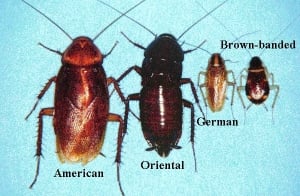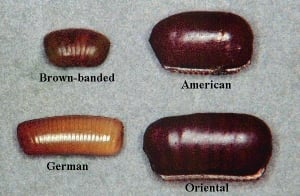COCKROACHES
The Isle of Wight Council enforces the Prevention of Damage by Pests Act 1949 and does not provide a pest control service. The landowner may have to pay for the treatment.
APPROVED PEST CONTROL CONTRACTORS
If the situation is severe or it is unclear what to do, professional pest control services are available. These companies employ trained pest control operators and have access to insecticides and equipment that are not available to the private individual.
Click here for a list of the Council’s Approved Pest Control Contractors
If in doubt telephone your local Environmental Health Department.
Tel: 01983 823000.


Cockroaches are among the most undesirable insect intruders in the home. They are associated with filth and unsanitary conditions, although they occasionally invade the best kept home. Known to carry various disease organisms, cockroaches have not been associated with any major disease outbreaks in this country. The insects also produce a secretion that has a repulsive odour and can affect the flavour of food. Studies have shown that cockroaches can cause allergic reactions when sensitive people come into contact with contaminated food or house dust.
Three cockroach life forms can be found in an infested area. The egg case is the size and shape of a baked bean and contains 10 to 20 cockroach eggs. The female may carry the eggs around until just before they hatch or, in some species, she may hide them in some protected area. As the eggs hatch, young cockroaches, or nymphs, emerge. Similar in shape and colour to the adults, they are smaller and wingless. Their habitats and food preferences are the same as those of adults. Cockroaches are active at night, so daytime observation is a good sign of a heavy infestation. They prefer protected areas, such as cracks and crevices, to rest and hide. Although cockroaches prefer starchy foods and meats, they will eat anything of plant or animal origin.
Where cockroaches are migrating into a building or from another part of a building, modifications such as weather stripping and caulking where plumbing passes from infested areas into un-infested areas will prevent problems. Eliminating hiding places, for example, caulking cracks and crevices in dark, moist areas, also will discourage cockroaches. Inspect items brought into a building, especially food containers, furniture, appliances and clothing. The adults and young will be easy to recognize, but because some cockroaches glue their egg cases to various surfaces, take particular care to look for the eggs. Cockroaches need food, water and shelter. Do not allow food particles to accumulate in areas accessible to cockroaches. Common feeding areas include unwashed dishes, pet feeding dishes, uncovered pet food containers, litter boxes, waste containers, and areas under refrigerators, stoves, sinks and furniture. Repair faulty plumbing and eliminate other unnecessary sources of water. Reduce shelter for cockroaches; do not store unnecessary newspapers, boxes, rags and similar items that provide hiding places.
Cockroach traps, small, open-ended boxes, contain an attractant and a sticky substance that retains the insects once they enter. Traps can be effective in catching the occasional invader, but they will not eliminate established colonies. Use them to locate infestations and to determine when populations require additional treatment. Traps are most effective when placed against walls under sinks, in cabinets and in basement corners. If two nights pass without a capture, move the trap to another likely area.
These leave a toxic deposit on surfaces and will kill cockroaches for a certain time period, usually two to four weeks. Apply to cracks and crevices where cockroaches hide and areas where they walk in search of food. Spray until the surface is wet, but avoid over applications that puddle or run off. Insecticides are poisons; they should be treated as such. If used improperly they can damage linoleum, carpets, drapes and paint. Insecticides recommended for residual treatments can be purchased in several forms under many commercial brand names.
These eliminate cockroaches only on contact. They will not eliminate an infestation, but are quite helpful when used with residual treatments. Several short-lasting aerosol insecticides are available. They irritate cockroaches and can be used to flush the pests out of their hiding places and force them into areas treated with a residual insecticide. This flushing action also is useful to determine whether or not cockroaches are present.
Insecticide dust formulations are able to penetrate cockroach hiding areas that other insecticides will not reach. When applied to dry locations, they have a longer useful life than residual sprays. There are several dusts available that do not contain organic chemical insecticides. Boric acid powder, which is available under several commercial names, is relatively safe for humans, but do not expose children and pets. It can cause skin irritations if improperly handled, and it will harm house plants. Apply boric acid only to hiding places and runways. It is slow acting. Do not expect complete control for at least one week after application. Most tests show boric acid is among the best cockroach insecticides which, combined with its relative safety, makes it a good choice for homeowners.
The other dusts available are applied in the same manner as boric acid. They may not be as effective as boric acid because they are repellent to the cockroach. However, they can keep the pests out of certain areas, such as wall voids and attics. Boric acid is a stomach poison. These other dusts wear through the protective waxes that cover the cockroach's body and cause death by dehydration.
Be sure to read and understand all label instructions before applying any residual sprays, non-residual sprays or insecticide dusts mentioned above.
For more information regarding this Leaflet please contact:
Environmental Health Service
Jubilee Stores
The Quay
Newport
Isle of Wight
PO30 2EH
Telephone: 01983 823000
Facsimile: 01983 529804
©Isle of Wight Council, May 2004
Page last updated on: 30/08/2007





